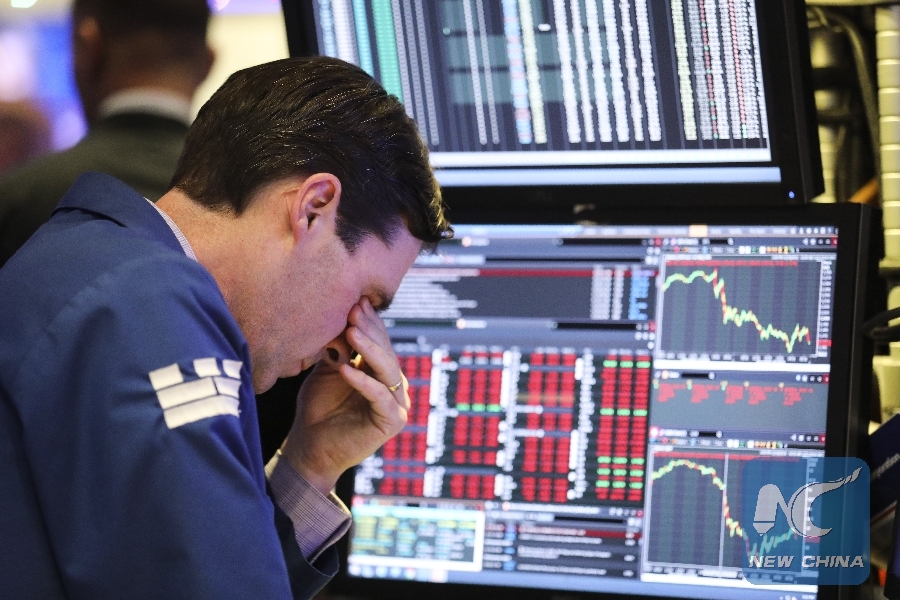
File Photo: A trader works at the New York Stock Exchange in New York, the United States, Dec. 20, 2018. (Xinhua/Wang Ying)
NEW YORK, Dec. 31 (Xinhua) -- U.S. stocks finished 2018 with their worst performance in a decade, as fears over the U.S. Federal Reserve's tightening policy and an economic slowdown, among others, caused the declines and further volatility is likely, experts said.
Despite a positive signal on Monday, the Dow and the S&P 500 indices have slid 5.6 percent and 6.2 percent in an annual drop respectively, both notching their biggest annual losses since the 2008 financial crisis. The Nasdaq sank 3.9 percent in 2018, also experiencing its worst year in a decade.
"The theme throughout 2018 has been news-driven market events. The market reacted to that more in 2018 than in other years," John Monaco, a trader with more than 35 years' experience on the floor, told Xinhua.
SELL-OFF AMID VOLATILITY
After setting a series of records through the late summer and early fall, major U.S. indices fell sharply after October amid volatility.
The S&P 500 and Nasdaq plunged 13.97 percent and 17.5 percent in the fourth quarter respectively, their worst quarterly performances since the fourth quarter of 2008, while the Dow fell nearly 12 percent, its worst period since the first quarter of 2009.
Sizable losses of U.S. equities came in the brutal December as investors fretted over fears of a monetary policy mistake by the Fed, an ongoing government shutdown in Washington and potential signals the global economy may be slowing down.
The three major indices decreased at least 8.7 percent for the month, with the Dow and S&P 500 reporting their worst December performance since 1931 and their biggest monthly loss since February 2009.
Volatility often happens when traders try to sell profitable shares before the closing of the year, said Monaco, adding that the market would continue to be volatile for a while in 2019.
The market turbulence was even more obvious after the Fed announced it would raise short-term interest rates by a quarter of a percentage point in its December statement. The move marked the Fed's fourth rate hike in 2018 and the ninth since late 2015, as the central bank moves forward on the path of monetary policy normalization.
Steven Mnuchin, the treasury secretary of the United States, called the heads of the six largest U.S. banks on Dec. 23, with the aim to stabilize the market.
INTEREST HIKES
The U.S. stock market was under pressure due to increasing concerns over rate hikes since the beginning of October.
Rising interest rates can be a hurdle to smaller companies that carry a high proportion of debt, so any sign that the Fed plans to continue to raise rates each quarter could weigh on corporate sentiment, said analysts.
"In the stock market, traders are grappling with the ugly reality during tightening cycles since the 1960s that, with just one exception, a series of rate hikes always ends in recession," said Chris Low, chief economist at FTN Financial.
"As long as the Fed continues to raise rates, the grim reality of an overhanging recession risk will be there and the prudent trade will be away from risk assets," he added.
"The U.S. stock market was driven lower as expectations for the pace of higher U.S. interest rate hikes take effect," said Brendan Ahern, chief investment officer at Krane Funds Advisors, LLC, a U.S. asset management firm.
With an expected slowdown in the U.S. economy, Fed officials envisioned two rate hikes next year, down from three estimated in September, according to its median forecast.
However, some analysts believe that there is a disparity of views between the central bank and investors on the softening in global economic growth, causing more uncertainty for the outlook of the equities market.
ECONOMIC SLOWDOWN
Concerns over a deceleration in the world's largest economy as well as global growth grew more credible in late 2018, which also rattled the market.
Investors were cautious, believing that a global economic slowdown was on the horizon. Weaker-than-expected data from major economies made them nervous that the world economy is likely to run out of steam sooner than they had anticipated, experts noted.
Bank of America (BofA) Merrill Lynch Global Research in early December forecasted a slowing global growth in 2019, saying that it is more a benign slowdown rather than a "recession."
Markets were in risk-off mode with investors simply trying to limit losses rather than aiming for outperformance.
The bear market vibe at the end of 2018 is expected to continue, with asset prices finding their lows in the first half of 2019 once rate expectations peak and global earnings expectations trough, said BofA Merrill Lynch in its 2019 outlook report. The bank also forecast a record-high peak in earnings for the S&P 500 next year and plenty of upside potential for investors who make volatility their new best friend.
"In our view, the current weakness in the markets is not a reflection of poor fundamentals. Rather, it's caused by a confluence of idiosyncratic shocks that create very real risks for investors to be concerned about but also opportunities for vigilant, well-positioned investors to pursue," said Candace Browning, head of BofA Merrill Lynch Global Research.
"Stocks trade up or down based on past stock price increases or decreases and based on forward earnings after careful analysis that includes demand for product," Monaco said, noting that it will be clearer and more definitive as to what traders will be doing after the holidays.

